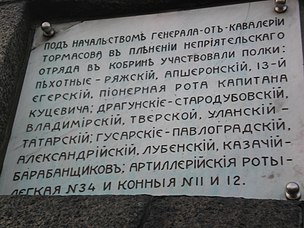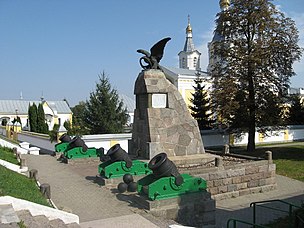
The Battle of Leipzig, also known as the Battle of the Nations, was fought from 16 to 19 October 1813 at Leipzig, Saxony. The Coalition armies of Austria, Prussia, Sweden, and Russia, led by Tsar Alexander I and Karl von Schwarzenberg, decisively defeated the Grande Armée of French Emperor Napoleon Bonaparte. Napoleon's army also contained Polish and Italian troops, as well as Germans from the Confederation of the Rhine. The battle was the culmination of the German Campaign of 1813 and involved 560,000 soldiers, 2,200 artillery pieces, the expenditure of 400,000 rounds of artillery ammunition, and 133,000 casualties, making it the largest battle of the Napoleonic Wars, and the largest battle in Europe prior to World War I.
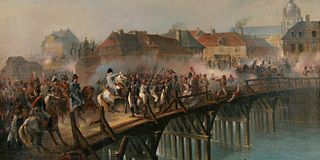
The Battle of Arcis-sur-Aube saw an Imperial French army under Napoleon face a much larger Allied army led by Karl Philipp, Prince of Schwarzenberg during the War of the Sixth Coalition. On the second day of fighting, Emperor Napoleon finally realized he had blundered into battle as he was massively outnumbered, and immediately ordered a masked retreat. By the time the Austrian Field Marshal Schwarzenberg realized Napoleon was retreating, most of the French had already disengaged and the Allied pursuit afterwards failed to prevent the remaining French army from safely withdrawing to the north. This was Napoleon's penultimate battle before his abdication and exile to Elba, the last being the Battle of Saint-Dizier.

The Battle of Brienne saw an Imperial French army led by Emperor Napoleon attack Prussian and Russian forces commanded by Prussian Field Marshal Gebhard Leberecht von Blücher. After heavy fighting that went on into the night, the French seized a château, nearly capturing Blücher. However, the French were unable to dislodge the Russians from the town of Brienne-le-Château. Napoleon himself, making his first appearance on a battlefield in 1814, was also nearly captured. Very early the next morning, Blücher's troops quietly abandoned the town and retreated to the south, conceding the field to the French.

The Battle of Dresden was a major engagement of the Napoleonic Wars. The battle took place around the city of Dresden in modern-day Germany. With the recent addition of Austria, the Sixth Coalition felt emboldened in their quest to expel the French from Central Europe. Despite being heavily outnumbered, French forces under Napoleon scored a victory against the Army of Bohemia led by Generalissimo Karl von Schwarzenberg. However, Napoleon's victory did not lead to the collapse of the coalition, and the weather and the uncommitted Russian reserves who formed an effective rear-guard precluded a major pursuit. Three days after the battle, the Allies surrounded and destroyed a French corps advancing into their line of withdrawal at the Battle of Kulm.
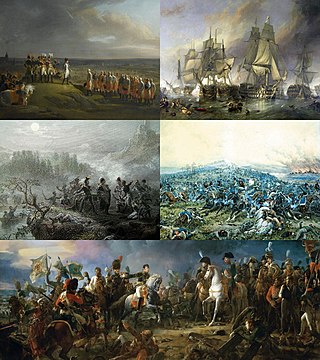
The War of the Third Coalition was a European conflict lasting from 1805 to 1806 and was the first conflict of the Napoleonic Wars. During the war, France and its client states under Napoleon I and its ally Spain opposed an alliance, the Third Coalition, which was made up of the United Kingdom, the Austrian Empire, the Russian Empire, Naples, Sicily, and Sweden. Prussia remained neutral during the war.

Count Alexander Petrovich Tormasov was a Russian cavalry general prominent during the Napoleonic Wars.

Prince Alexander Ivanovich Chernyshyov, General of Cavalry (1827), was a Russian military leader, diplomat and statesman, whose career began in the Napoleonic Wars. After the Battle of Austerlitz (1805), he carried out successful diplomatic missions to France and Sweden and served with distinction in battles of 1812 and 1813. Chernyshyov rose through the ranks to the role of Russian Minister of War (1827–1852), chairman of the State Council and Cabinet of Ministers (1848–1856), and acquired the styles from Count (1826) to Serene Prince (1849).
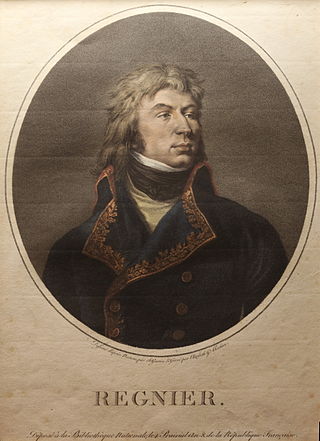
Jean Louis Ébénézer Reynier was a Swiss-French military officer who served in the French Army under the First Republic and the First Empire. He rose in rank to become a general during the French Revolutionary Wars and led a division under Napoleon Bonaparte in the French campaign in Egypt and Syria. During the Napoleonic Wars, he continued to hold important combat commands, eventually leading an army corps during the Peninsular War in 1810–1811 and during the War of the Sixth Coalition in 1812–1813.
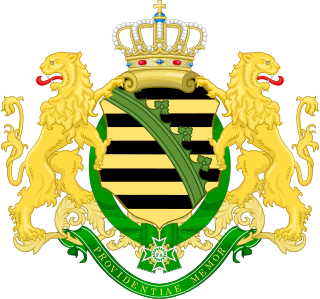
The Royal Saxon Army was the military force of the Electorate (1682–1807) and later the Kingdom of Saxony (1807–1918). A regular Saxon army was first established in 1682 and it continued to exist until the abolition of the German monarchies in 1918. With the formation of the Confederation of the Rhine by Napoleon the Royal Saxon Army joined the French "Grande Armée" along with 37 other German states.

The Battle of Schleiz took place on 9 October 1806 in Schleiz, Germany between a Prussian-Saxon division under Bogislav Friedrich Emanuel von Tauentzien and a part of Jean-Baptiste Bernadotte's I Corps under the command of Jean-Baptiste Drouet, Comte d'Erlon. It was the first clash of the War of the Fourth Coalition, part of the Napoleonic Wars. As Emperor Napoleon I of France's Grande Armée advanced north through the Franconian Forest it struck the left wing of the armies belonging to the Kingdom of Prussia and the Electorate of Saxony, which were deployed on a long front. Schleiz is located 30 kilometers north of Hof and 145 kilometers southwest of Dresden at the intersection of Routes 2 and 94.
The Second Western Army was created during 1810 as part of the reform of the Imperial Russian Army as a whole and was intended to defend the central western region of the Russian border with Poland to the Austrian border during the expected French invasion of Russia.
The Third Reserve Army of Observation was a Russian army created during 1811 as an impromptu force to watch the Austrian frontier when it became apparent that the Austrian Emperor would possibly send troops into Russia as part of the French invasion of Russia. It had 44,000 men and 168 guns. Alexander Tormasov took command of the army on 27 March 1812. It was renamed the Third Western Army on 30 September 1812 following its merger with the Army of the Danube. The Third Western Army, led by Pavel Chichagov, failed to cut off Napoleon's army's retreat, though it followed the French into Poland the following January.

This is the order of battle of the French invasion of Russia.
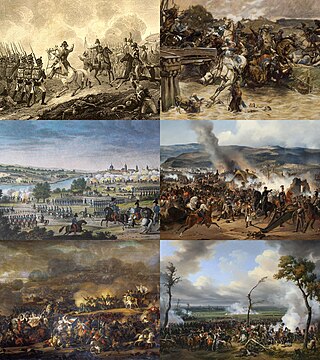
The German campaign was fought in 1813. Members of the Sixth Coalition, including the German states of Austria and Prussia, plus Russia and Sweden, fought a series of battles in Germany against the French Emperor Napoleon, his marshals, and the armies of the Confederation of the Rhine – an alliance of most of the other German states –, which ended the domination of the First French Empire.
The VII Corps of the Grande Armée was a French military unit that existed during the Napoleonic Wars. It was formed in 1805 and assigned to Marshal Pierre Augereau. From 1805 to 1807, Augereau led the VII Corps in the War of the Third Coalition and the War of the Fourth Coalition. It was disbanded after being nearly wiped out at the Battle of Eylau in February 1807 and its surviving troops were distributed to other corps.
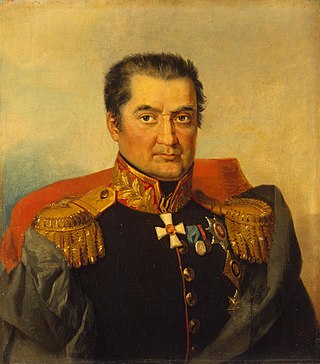
Yevgeni Ivanovich Markov, was a Russian infantry commander during the French Revolutionary Wars and the Napoleonic Wars.

The Battle of Laubressel saw the main Allied army of Field Marshal Karl Philipp, Prince of Schwarzenberg mount a three-pronged converging attack on the weaker army of Marshal Jacques MacDonald. The French forces under Marshal Nicolas Oudinot bore the brunt of the fighting, in which the Allies tried to turn their left flank. The French abandoned Troyes and retreated west as a result of the action. The village of Laubressel is located 10 kilometres (6 mi) east of Troyes.

Aleksey Petrovich Melissino was a Russian military commander during the Patriotic War of 1812, advancing to the rank of major general. He was the last of the Melissino family in Russia.
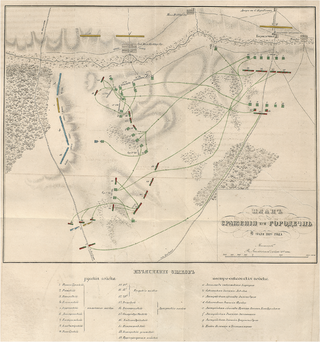
The Battle of Gorodechno took place between an army of the Austrian and Saxon allies of Napoleonic France under the command of the Prince of Schwarzenberg and Russian troops under Alexander Tormasov at Gorodechno, a town in Kobrinsky Uyezd, Grodno Governorate. The battle was ultimately won by France's allies when Tormasov was forced to retire.

The Battle of Wolkowisk (Volkovysk) took place 14–16 November 1812 near the village of Wolkowisk, where 35,000 Austrian, Saxon and French soldiers under Karl Philipp, Prince of Schwarzenberg defeated 27,000 Russian soldiers under Fabian Gottlieb von der Osten-Sacken.


